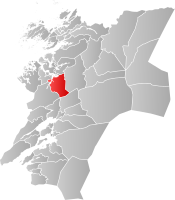Klinga (municipality)
Klinga herred | |
|---|---|
 Nord-Trøndelag within Norway | |
 Klinga within Nord-Trøndelag | |
| Coordinates: 64°24′35″N 11°28′56″E / 64.40972°N 11.48222°ECoordinates: 64°24′35″N 11°28′56″E / 64.40972°N 11.48222°E | |
| Country | Norway |
| County | Nord-Trøndelag |
| District | Namdalen |
| Established | 1 Jan 1891 |
| Disestablished | 1 Jan 1964 |
| Administrative centre | Bangsund |
| Area | |
| • Total | 352 km2 (136 sq mi) |
| *Area at municipal dissolution. | |
| Population (1964) | |
| • Total | 2,482 |
| • Density | 7.1/km2 (18/sq mi) |
| Demonym(s) | klingbygg[1] |
| Time zone | UTC+01:00 (CET) |
| • Summer (DST) | UTC+02:00 (CEST) |
| ISO 3166 code | NO-1746 |
| Preceded by | Vemundvik in 1891 |
| Succeeded by | Namsos in 1964 |
Klinga is a former municipality in the old Nord-Trøndelag county, Norway. The 352-square-kilometre (136 sq mi) municipality existed from 1891 until its dissolution in 1964. The municipality encompassed the mainland areas south of the river Namsen in what is now the municipality of Namsos in Trøndelag county. The administrative centre was the village of Bangsund. Other villages in Klinga included Spillum and Klinga where Klinga Church is located.[2]
History[]
The municipality of Klingen was established on 1 January 1891 when the municipality of Namsos herred was divided in two. The northern part became the municipality of Vemundvik (population: 1,387) and the southern part became the municipality of Klingen (population: 1,387). In 1917, the name of the municipality was changed to Klinga.[3]
During the 1960s, there were many municipal mergers across Norway due to the work of the Schei Committee. On 1 January 1964, the neighboring municipalities of Vemundvik (population: 2,040) and Klinga (population: 2,482) plus the parts of Otterøy municipality located north of the Namsenfjorden (population: 1,013) and the Finnangerodden area on the island of Otterøya in Fosnes municipality (population: 116) were all merged with the town of Namsos (population: 5,224) to create a new (much larger) municipality of Namsos with 10,875 residents.[3]
Government[]
All municipalities in Norway, including Klinga, are responsible for primary education (through 10th grade), outpatient health services, senior citizen services, unemployment and other social services, zoning, economic development, and municipal roads. The municipality is governed by a municipal council of elected representatives, which in turn elects a mayor.[4]
Municipal council[]
The municipal council (Herredsstyre) of Klinga was made up of 15 representatives that were elected to four year terms. The party breakdown of the final municipal council was as follows:
| Party Name (in Norwegian) | Number of representatives | |
|---|---|---|
| Labour Party (Arbeiderpartiet) | 10 | |
| Communist Party (Kommunistiske Parti) | 1 | |
| Christian Democratic Party (Kristelig Folkeparti) | 1 | |
| Centre Party (Senterpartiet) | 1 | |
| Joint List(s) of Non-Socialist Parties (Borgerlige Felleslister) | 2 | |
| Total number of members: | 15 | |
| Party Name (in Norwegian) | Number of representatives | |
|---|---|---|
| Labour Party (Arbeiderpartiet) | 9 | |
| Communist Party (Kommunistiske Parti) | 1 | |
| Christian Democratic Party (Kristelig Folkeparti) | 1 | |
| List of workers, fishermen, and small farmholders (Arbeidere, fiskere, småbrukere liste) | 1 | |
| Joint List(s) of Non-Socialist Parties (Borgerlige Felleslister) | 3 | |
| Total number of members: | 15 | |
| Party Name (in Norwegian) | Number of representatives | |
|---|---|---|
| Labour Party (Arbeiderpartiet) | 6 | |
| Communist Party (Kommunistiske Parti) | 1 | |
| Christian Democratic Party (Kristelig Folkeparti) | 1 | |
| List of workers, fishermen, and small farmholders (Arbeidere, fiskere, småbrukere liste) | 2 | |
| Local List(s) (Lokale lister) | 2 | |
| Total number of members: | 12 | |
| Party Name (in Norwegian) | Number of representatives | |
|---|---|---|
| Labour Party (Arbeiderpartiet) | 6 | |
| Communist Party (Kommunistiske Parti) | 2 | |
| Christian Democratic Party (Kristelig Folkeparti) | 1 | |
| Joint List(s) of Non-Socialist Parties (Borgerlige Felleslister) | 3 | |
| Total number of members: | 12 | |
| Party Name (in Norwegian) | Number of representatives | |
|---|---|---|
| Labour Party (Arbeiderpartiet) | 7 | |
| Communist Party (Kommunistiske Parti) | 2 | |
| Joint List(s) of Non-Socialist Parties (Borgerlige Felleslister) | 3 | |
| Total number of members: | 12 | |
| Party Name (in Norwegian) | Number of representatives | |
|---|---|---|
| Labour Party (Arbeiderpartiet) | 8 | |
| Joint List(s) of Non-Socialist Parties (Borgerlige Felleslister) | 4 | |
| Total number of members: | 12 | |
See also[]
References[]
- ^ "Navn på steder og personer: Innbyggjarnamn" (in Norwegian). Språkrådet.
- ^ Rosvold, Knut A., ed. (2018-04-19). "Bangsund". Store norske leksikon (in Norwegian). Kunnskapsforlaget. Retrieved 2018-04-21.
- ^ a b Jukvam, Dag (1999). "Historisk oversikt over endringer i kommune- og fylkesinndelingen" (PDF) (in Norwegian). Statistisk sentralbyrå.
- ^ Hansen, Tore, ed. (2016-05-12). "kommunestyre". Store norske leksikon (in Norwegian). Kunnskapsforlaget. Retrieved 2020-02-02.
- ^ "Kommunevalgene og Ordførervalgene 1959" (PDF) (in Norwegian). Oslo: Statistisk sentralbyrå. 1960. Retrieved 2020-04-14.
- ^ "Kommunevalgene og Ordførervalgene 1955" (PDF) (in Norwegian). Oslo: Statistisk sentralbyrå. 1957. Retrieved 2020-04-14.
- ^ "Kommunevalgene og Ordførervalgene 1951" (PDF) (in Norwegian). Oslo: Statistisk sentralbyrå. 1952. Retrieved 2020-04-14.
- ^ "Kommunevalgene og Ordførervalgene 1947" (PDF) (in Norwegian). Oslo: Statistisk sentralbyrå. 1948. Retrieved 2020-04-14.
- ^ "Kommunevalgene og Ordførervalgene 1945" (PDF) (in Norwegian). Oslo: Statistisk sentralbyrå. 1947. Retrieved 2020-04-14.
- ^ "Kommunevalgene og Ordførervalgene 1937" (PDF) (in Norwegian). Oslo: Statistisk sentralbyrå. 1938. Retrieved 2020-04-14.
- Namsos
- Former municipalities of Norway
- 1891 establishments in Norway
- 1964 disestablishments in Norway



